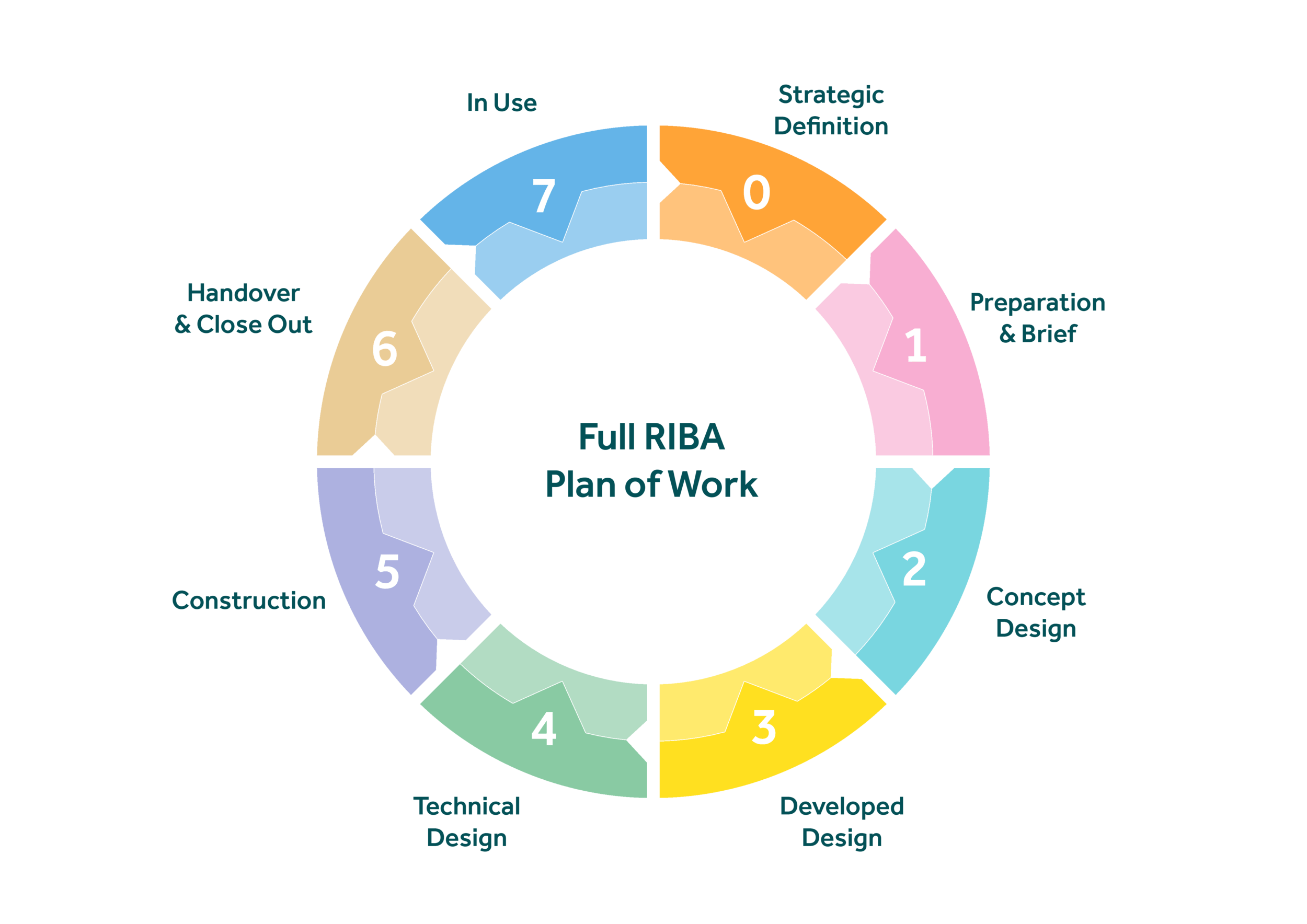5 min read
Marketing to Architects: The Specification Process & RIBA PLAN OF WORK
![]() Jack Meisinger
:
16-Aug-2023 17:05:54
Jack Meisinger
:
16-Aug-2023 17:05:54

Before you start getting into the tactics of how to market to architects, it’s important to understand the specification process they go through, and how that fits into the project life cycle.
This enables you to convey the right messages, and provide the right materials, at the right time.
One caveat before we get started. Timing your communications to stages of projects is difficult. Even with the best data. By creating a complete library of resources that are easily found online, you allow specifiers to come to you on their terms, in their timing.
But an understanding of the project life cycle is helpful for two reasons. You understand the world of the architect better and can anticipate the materials they may need for each stage of their project.
This article will cover the process an architect goes through when conceptualising a design and researching and specifying products. By understanding this and developing resources to support them every step of the way, your spec will become unbreakable!
Keep reading to find out how.
Marketing to ARCHITECTS: The Specification Process
The specification process of an architect is the selection of products, materials, and systems to be used in a construction project. This process is a critical part of architectural design and involves specifying the exact requirements and characteristics of each item necessary to bring the project to completion.
The specification process typically follows these steps:
Project Scope Definition. The architect starts by understanding the client's requirements and project goals. This includes determining the purpose of the building, its size, location, budget, and any specific design considerations.
Building Codes and Standards. The architect researches and understands the relevant building codes, regulations, and industry standards that apply to the project. Compliance with these codes is essential for ensuring safety and legal requirements.
Guides or CPD on building codes are useful at this stage.
Preliminary Design. The architect develops a preliminary design concept that outlines the overall layout and appearance of the building. During this phase, general materials and systems may be discussed, but detailed specifications are not yet finalised.
Inspirational material is important here.
Product Research and Evaluation. Based on the preliminary design, the architect researches and evaluates various products, materials, and systems available in the market. Factors considered include quality, durability, performance, sustainability, cost, and aesthetics.
Making sure you show up during this process is important. Great SEO, robust product pages, and technical materials are a must.
Product Selection. The architect narrows down the options and selects specific products and materials that best meet the project's functional and aesthetic requirements.
Technical Specifications. The architect prepares detailed technical specifications for each selected product. These specifications outline the exact requirements, standards, and performance characteristics the products must meet.
Technical drawings and BIM are critical here - although the architect may be looking for them earlier, just to make sure they are available.
Coordination with Other Consultants. The architect collaborates with other consultants, such as structural engineers, mechanical engineers, and electrical engineers, to ensure that the selected products and materials align with the overall building design and engineering requirements.
Specifying Manufacturer's Details. In some cases, the architect may specify products from specific manufacturers or brands, particularly when certain products are integral to the design or required for compatibility with other building systems.
Clarifying the unique, irreplaceable attributes of your product throughout your materials makes sure your spec doesn't get broken when handed over to the quantity surveyor.
Construction Documents. The detailed technical specifications are included in the construction documents, along with architectural drawings and other essential information. These documents are used by contractors to bid on the project and construct the building.
Bidding and Construction. The project is put out for bidding, and contractors review the specifications and drawings to provide accurate cost estimates. Once a contractor is selected, the construction phase begins, with the selected products and materials being used as specified.
If you intend to market to architects throughout the specification process, you must anticipate the questions they’ll have at each stage, and provide resources to answer those questions those in a place they can access them easily (easy-to-google articles and digital assets - eBooks, Regulation Guides, BIM Files, etc).
Marketing to architects: The Project Life cycle
Next, let’s consider the life cycle of a typical construction project, so we can see where the specification process fits into the overall project life cycle.
In 2020, RIBA published the RIBA Plan of work, based on nearly seven years of feedback from the construction industry, to help establish the process of briefing, designing, constructing, and operating building projects.
The 8 stages of a project are:
0. Strategic Definition
1. Preperation and Briefing
2. Concept Design
3. Spatial Coordination
4. Technical Design
5. Manufacturing and Construction
6. Handover
7. Use

To reach architects, building product manufacturers should focus their marketing efforts primarily on two key stages:
Stage 2: Concept Design
At this early stage of the RIBA Plan of Work, architects are exploring design concepts and developing the initial vision for the project. It is an opportune time for building product manufacturers to engage with architects and introduce their products, materials, and innovative solutions that align with the project's design intent. By showcasing how their products can contribute to the project's overall concept and meet specific design requirements, manufacturers can influence material selection decisions from the beginning.
Architects are open to exploring new possibilities during the concept design phase, making it an ideal time for building product manufacturers to present their offerings. Marketing efforts during this stage should focus on providing compelling product information, technical data, case studies, and visual representations to demonstrate how the products can enhance the project's design and performance.
Stage 4: Technical Design
In the Technical Design stage, architects are refining the project's design and creating detailed construction drawings and specifications. At this point, building product manufacturers can further engage with architects by providing comprehensive technical information, product specifications, and compliance details.
Building product manufacturers should emphasize how their products meet industry standards, offer efficiency, sustainability, and support seamless integration into the design. Providing clear documentation, test reports, and certifications will significantly influence architects' choices during this decision-making phase.
By targeting architects at these key stages, building product manufacturers can increase their chances of getting specified in projects, as well as build strong relationships with architects based on the mutual understanding of design intent and technical requirements. Early engagement allows manufacturers to become trusted partners throughout the RIBA Plan of Work, from concept design through to construction and beyond.
Conclusion
While it is important to understand the plan of work, success depends upon making yourself an available resource, rather than knocking down the door at the right time, because there is so much variability in the timing of a construction project, and these things are difficult to track.
While this data is helpful, a better plan is to make sure you are showing up in the places that architects search when looking for new products, and providing robust materials to answer all of their questions. This allows you to support them on their terms, instead of showing up uninvited in their inbox with a promotional email.
Only after you have laid this foundation of resources which are easy to find online, and fully suppport the specification process, then timely campaigns should be employed to try to connect with specifiers at these ideal stages of the RIBA Plan of Work.
For more information on How to Market to Architects, sign up for our newsletter.
ABOUT INSYNTH
At Insynth we deliver a predictable flow of leads, customers, and specifications for building product brands through our inbound marketing approach, proven to connect with a technically demanding audience.
The latest marketing techniques such as construction inbound marketing, help building product companies to grow sustainability.
As the only HubSpot-certified agency to major in construction marketing. We have a proven formula of bringing a variety of functionalities together including CRM Implementation, Web Design, SEO, and Content Marketing to achieve your ultimate aim: Growing your business and gaining new specifiers and customers.
Book A Free Consultation Today to discover more.



